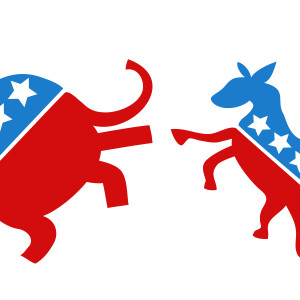Editor’s Note: See here for an alternative view on polarization. Counterpoint: The Positive Side of Political Polarization
Political polarization is a serious problem for the United States because it impedes steps necessary to solve mounting national problems. These problems include rising levels of government debt, illegal immigration, spending on entitlement programs, the deterioration of America’s roads, bridges, railways and airports, the impending failure of employee pension systems, and lackluster economic growth, not to mention various pressing international issues.
If the two parties cannot compromise to address these issues, then they will gradually grow to a point of crisis, at which point it may be too late to do very much about them.
Political polarization between the two parties has grown to a point that Americans have not seen since the 1890s, and perhaps not since the 1850s when the nation was in the process of coming apart over the slavery issue.
Scholars have found that Republican voters and officeholders have become much more conservative since the 1970s while Democrats have grown increasingly liberal. From the late 1930s into the 1960s, roughly half the members of the House and Senate were “moderates” as measured by their voting records. The parties had not yet separated into rival ideological camps.
The existence of a large body of moderates in Congress facilitated compromise and a fair degree of consensus between the two parties. Thus, it was necessary to craft bipartisan coalitions in order pass important legislation. All of the important legislative achievements of that era were passed with bipartisan majorities, including the Civil Rights Bill of 1964, Medicare and Medicaid (1965), the Kennedy tax cuts (1964), the highway bills of the 1950s, and the nation’s Cold War policies from the late 1940s through the mid-1960s. There were no threats of “government shutdowns” during that entire era.
Since that time, the number of moderates has steadily declined as the parties have moved in opposite ideological directions, dividing into liberal and conservative camps.
In the early 1980s the proportion of moderates in Congress dropped below 40 percent for the first time in the post-war era, and by the late 1990s it had fallen below 20 percent. Today less than 10 percent of the members of Congress can be called moderates on a liberal-conservative scale.
By the same process, the ideological distance between Democrats and Republicans has increased year by year. Students of public opinion have observed a similar pattern among voters: they are now sharply polarized, express strong dislike for the opposing party and its voters, and do not trust the government to enact policies in the public interest.
There was a time in America when parents feared that a son or daughter might marry someone of a different religious faith; today, they tend to worry more that a child might marry someone of a different political faith.
In addition, the various states in the union have moved in opposite political directions, some becoming safe havens for Democrats and others for Republicans. It would be easy to point to other measures of increased polarization. A polarized and distrustful political system will never yield the compromises needed to address the serious problems the country is now facing.
It is true that President Obama achieved some victories in this polarized environment, but at a high cost to his popularity and the Democratic Party’s standing in Congress. In addition, some of his signal achievements — such as his health care bill and the nuclear treaty with Iran — will be reversed as soon as a Republican president is elected.
It is hard to know exactly what has caused political polarization in America. To some extent, people “vote with their feet” and gradually separate into different jurisdictions based upon political views and lifestyle preferences. This process is aided by technology that allows citizens to communicate only to those already in agreement.
Over time in any political system the rival “teams” will accumulate grievances against one another to the point where they lose any interest in communicating across party lines. This happened in the 1850s: We know what happened as a consequence of that development. Things are not going to get that bad in America this time around, but they could get plenty bad if and when we have another serious recession or the stock market loses 30 percent or 40 percent of its value. Sadly, it appears that as a nation we are no longer capable of making preparations for such events.

